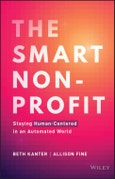A pragmatic framework for nonprofit digital transformation that embraces the human-centered nature of your organization
The Smart Nonprofit turns the page on an era of frantic busyness and scarcity mindsets to one in which nonprofit organizations have the time to think and plan - and even dream. The Smart Nonprofit offers a roadmap for the once-in-a-generation opportunity to remake work and accelerate positive social change. It comes from understanding how to use smart tech strategically, ethically and well.
Smart tech does rote tasks like filling out expense reports and identifying prospective donors. However, it is also beginning to do very human things like screening applicants for jobs and social services, while paying forward historic biases. Beth Kanter and Allison Fine elegantly outline the ways smart nonprofits must stay human-centered and root out embedded bias in order to success at the compassionate and creative work that only humans can and should do.
Table of Contents
Preface xix
Acknowledgments xxi
Part I Understanding and Using Artificial Intelligence 1
Chapter 1 Becoming a Smart Nonprofit 3
Introduction 3
Understanding Smart Tech 7
Becoming a Smart Nonprofit 10
A Real-World Smart Nonprofit 12
The Dangers of Automation 15
About This Book 17
Conclusion 18
Chapter 2 Leading Smart Nonprofits 21
Introduction 21
The Busyness Paradox 22
Creating Healthy Cultures 24
Smart Tech and Jobs 27
Leading through Resistance 29
Conclusion 35
Chapter 3 The Evolution of Smart Tech 39
Introduction 39
A Brief History 40
Digital Eras and Disruptive Technology 42
Accelerating into the Autonomous World 43
Key Aspects of the Autonomous World 44
AI4Good 47
Conclusion 52
Chapter 4 Staying Human-Centered 57
Introduction 57
Man vs. Machine 57
Co-botting 59
Human-Centered Design 62
Conclusion 67
Chapter 5 Data, Data, Data 69
Introduction 69
Big Data 70
Understanding Data Science 72
Data Planning for Your Organization 74
Third-Party Data Sets 75
Second-Party Data 76
Conclusion 80
Chapter 6 Ethical and Responsible Use 83
Introduction 83
Responsible Use 84
Rooting Out Embedded Bias 86
Digital Privacy 89
Creating Ethical Standards 95
Smart Tech and Governance 97
Conclusion 100
Part II The Smart Nonprofit Use-Case Examples and Management 105
Chapter 7 Ready, Set, Go 107
Introduction 107
Ready 108
Set 116
Go 119
Conclusion 123
Chapter 8 Automating Program Delivery 125
Introduction 125
Creating More Capacity 125
Overcoming Service Barriers 127
Crisis Intervention 130
Removing Barriers to Accessibility 131
Advocacy 132
Conclusion 134
Chapter 9 Fundraising 139
Introduction 139
The Leaky Boat Problem 139
Using Smart Tech for Relational Fundraising 143
The Future of Giving 148
Conclusion 149
Chapter 10 Automating the Back Office 153
Introduction 153
Human Resources 153
Workplace Well-Being and Automation 156
Financial Management 161
Improving Organization-wide Workflow 162
Editing, Customizing, and Reviewing Content 164
Project Management 164
Conclusion 165
Chapter 11 Smart Philanthropy 169
Introduction 169
Automating Donor Advising 170
Philanthropic Investment in the Use of Smart Tech for Social Good 173
Conclusion 176
Part III Where We Go From Here 179
Chapter 12 A Smarter Future 181
Introduction 181
The Future of Nonprofit Work 181
A Better Path Forward 182
Societal Changes 184
Conclusion 189
Glossary: The Vocabulary of Smart Tech 193
Resources/Bibliography 199
About the Authors 207
Index 209








